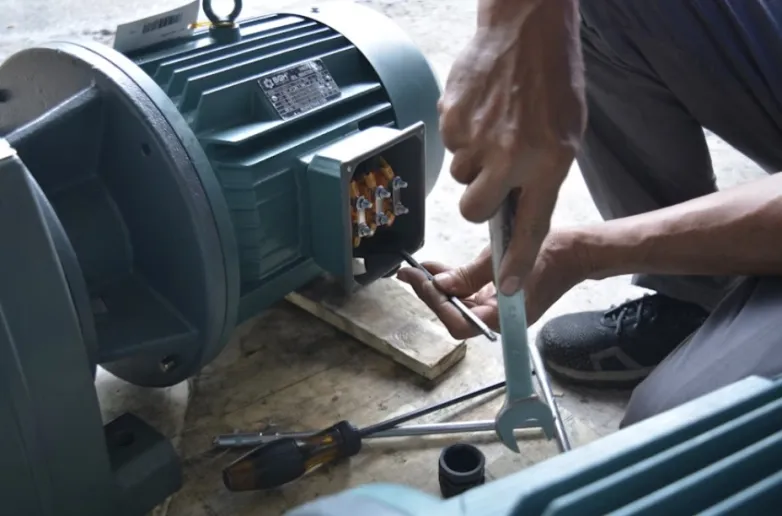Understanding Electric Motor Efficiency: Key Factors and Innovations

Looking to amp up your motor performance?
Electric motor efficiency is more than just a technical term; it's the difference between soaring energy bills and serious cost savings. And now, with electric motors boasting up to 96.3% efficiency, the time has never been better to get to know these powerhouses inside and out.
Before we dive into all the juicy details…
Let's get one thing straight.
Motor efficiency directly affects your bottom line. With the global electric motor market expected to hit $268.2 billion by 2034, you know getting this right is important.
Here's what you'll discover in this article:
-
Why Electric Motors Efficiency Matters (Hint: It's About Money)
-
Innovations Raising the Performance Bar
-
Essential Factors Driving Motor Efficiency
-
Key Trends for the Future of Efficiency
Why Electric Motors Efficiency Matters (Hint: It's About Money)
Motor efficiency is easy to understand.
Simply put, it's the ratio of mechanical power output to electrical power input. It's a measure of how much of the electrical energy you put in the motor becomes useful work.
But, here's what most people don't know…
Your electric motor and inverter don't operate independently. The inverter handles the power supply while the motor itself transforms that energy into rotation. When you pair these elements like those provided by specialty companies such as RJW Motors & Inverters perfectly, the overall system becomes more efficient across the complete power range.
If you don't believe me, take a look at the math:
A 95% efficient motor compared to a 90% efficient motor may not seem like much, right? Think again. When your motors are operating 24/7, that 5% difference adds up to huge savings in energy costs in a matter of months, not years. In industrial environments where motors are workhorses, efficiency doesn't just matter…
It's everything.
Did you know that higher-efficiency motors also generate less heat? And, less heat not only means longer motor life, but it also can lead to a reduced cooling requirement and lower maintenance cost.
Get all that for the price of one upgrade. That's a great return on investment if you ask me.
Innovations Raising the Performance Bar
The motor world is evolving at warp speed.
Seriously fast.
In the last couple of years, we've seen efficiency levels jump from around 93% to north of 96% in the premium electric motors category. But, what's behind these impressive gains?
Advanced Magnetic Materials
High-performance neodymium magnets are transforming motor design, creating more robust magnetic fields in smaller packages, which directly increases torque and efficiency.
The downside? Cost and supply issues. Manufacturers are working on heavy-rare-earth-free motors to counter this problem.
Copper Rotor Technology
Did you see this?
Motors with copper rotors can achieve 12-15% less motor loss compared to standard aluminum rotors. Copper has better conductivity which means less electrical resistance, and that results in better efficiency.
High-Temperature Superconductors
Are you ready for this?
High-temperature superconductors (HTS) have started to show up in some of the leading-edge motor designs. These materials slash electrical resistance, which is especially useful for high-power applications where every bit of efficiency improvement counts.
Smart Cooling Systems
Heat. We talked about it before.
Cooling tech has taken a leap forward. Some manufacturers are now running cooling oil right through the copper windings, not just around it. This kind of direct cooling allows the motor to handle more power without sacrificing peak efficiency.
Essential Factors Driving Motor Efficiency
All motors aren't created equal.
There are several critical factors that determine how well your motor turns electricity into mechanical power. Figuring out what these are will help you make better choices when you are selecting motors for your needs.
Load Matching
Ah, yes. The most often overlooked efficiency factor.
Motors run best between 75% and 100% of their rated load. A motor being run at 25% load is nowhere near as efficient as one operating at a higher load. Size the motor correctly at the start and you will get better efficiency straight away.
Variable Speed Drives (VSDs)
Got a simple way to improve efficiency?
Plug a variable speed drive onto your motor. VSDs can match the motor's speed to the actual load requirements rather than just running at full power all the time. In pumps and fans, for example, this can lead to energy savings of 20-50%.
Power Factor
Let me guess, power factor has you stumped…
Power factor is the measure of how effectively electrical power is turned into mechanical work. A low power factor means that you are paying for energy that doesn't result in useful output. Motors that have good power factor correction can make a big difference in energy waste.
Temperature Management
Heat is your enemy.
For every 10°C increase in operating temperature, your motor life is reduced by about 50%. Keep your motor cool with good ventilation, cooling, and thermal management. That has a direct impact on both efficiency and motor life.
Here's the important parts:
-
Good airflow around the motor
-
Cleaning the fins and air passages to prevent blockage
-
Keep the ambient temperatures in check
-
Watch your thermal loading with regular monitoring
Key Trends for the Future of Efficiency
The future of motor efficiency is being written right now.
AI-Powered Motor Control
Artificial intelligence is making its way into motor control systems. AI can optimize in real-time, make maintenance predictive, and adjust motor performance on the fly for better efficiency. These smart systems learn your usage patterns and tweak settings automatically.
Axial Flux Motor Architecture
Axial flux motors aren't your typical radial motors. They arrange their magnetic fields parallel to the axis of rotation, which is different than radial flux. The change to Axial flux motor design means you get more power in a smaller package and that also helps with efficiency.
The torque and diameter of an Axial flux motor are related to the 3rd power of diameter. That is a geeky way of saying you get a lot more torque from a small motor.
Advanced Manufacturing Techniques
Precision in the manufacturing is helping motors become more efficient. Techniques like having direct cooling applied to the copper windings, using the right winding patterns, and employing advanced core materials are all becoming the norm for premium motors.
Sustainable Material Innovation
Sustainability is a hot topic these days. Manufacturers are trying to come up with alternatives to rare earth elements that are also environmentally friendly. These new materials are making motors greener without compromising their efficiency ratings.
System Integration Matters
Here's where things get interesting…
System thinking.
A motor doesn't live in a vacuum. It works in conjunction with drives, controls, mechanical loads, and the power source. Optimizing the entire setup, not just the motor, is how you get the most efficiency.
Here's what to think about:
-
Motor and drive compatibility and tuning
-
Coupling efficiency between the motor and mechanical load
-
Load characteristics and how they vary
-
Power quality and supply
-
Ambient environmental conditions
Wrapping It Up
Electric motor efficiency is bigger than just the motor itself.
It's a game of understanding all the moving parts and how they work together to turn electrical energy into mechanical work that we can use. With new materials, smart control systems powered by AI optimization, and…
The efficiency game is changing quickly.
Motors hitting the 96%+ efficiency marks now are using tech that wasn't available 5 years ago. Copper rotors, direct cooling, advanced magnetic materials, and intelligent control systems are all helping to push the limits.
But, let's not forget…
Efficiency is pointless if you can't use it properly.
Size your motors right, match them to the correct drives, and keep them well-maintained. The most efficient motor isn't going to do you any good if you have an oversized motor for the job, or if it's poorly maintained.
The moral of the story: Motor efficiency gains lead to real-world savings, longer equipment life, and better performance. With current technology, there's no excuse for running inefficient motors when better, more efficient options are available.
Also read
- How to Reduce Downtime in Solar Operations?
- Hyperparameter Tuning Good Practices for Robust Predictive Models
- 5 Critical Metal Forming Processes in Solar Panel Manufacturing
- Maximizing Efficiency with Low-Maintenance Solar Panel Systems
- Cyber Hygiene for Solar Companies: Protecting Your Data from Email Threats


